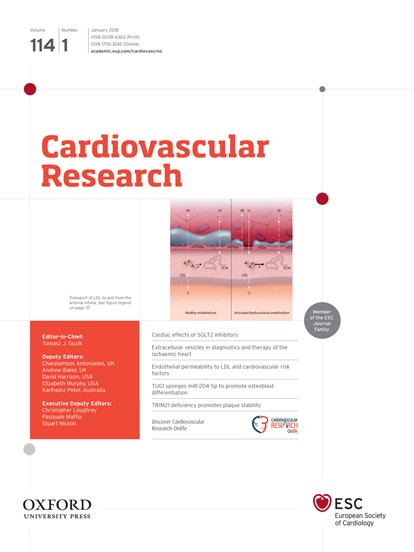-
PDF
- Split View
-
Views
-
Cite
Cite
Simon Sedej, Ketone bodies to the rescue for an aging heart?, Cardiovascular Research, Volume 114, Issue 1, 01 January 2018, Pages e1–e2, https://doi.org/10.1093/cvr/cvx218
Close - Share Icon Share

Dr. Simon Sedej is an Associate Professor of Physiology at the Department of Cardiology of the Medical University of Graz, Austria. His research focuses on the mechanisms underlying age-related cardiometabolic decline and its effects on functional and structural myocardial remodeling using relevant animal models. He is the coordinator of the MINOTAUR (Metabolic Therapy for Managing Diastolic Heart Failure) project funded by the ERA-CVD/Transnational Research Projects on Cardiovascular Diseases (2017-2020). Recently, Dr. Sedej made a significant contribution to the discovery that the natural polyamine and caloric restriction mimetic spermidine is cardioprotective in the setting of aging and hypertension-inducedheart failure.
Commentary on ‘Ketogenic Diet Reduces Midlife Mortality and Improves Memory in Aging Mice’ by Newman et al., Cell Metabolism, 2017.4
Adverse dietary habits increase obesity and exacerbate the functional decline of the aged heart. Caloric restriction or dietary modifications reduce obesity, delay aging and protect against age-related pathologies, including cardiovascular disease.1 However, the inability of most individuals to follow rigorous diets, as well as their potential adverse effects, limits their implementation. One such dietary regimen that mimics healthspan-promoting effects of caloric restriction is ketogenic diet (KD), which consists of high-fat and low- or no-carbohydrate. Standard KD efficiently reduces body weight and stimulates hepatic synthesis of ketone bodies (KB; acetoacetate, β-hydroxybutyrate and acetone).2 Ketones are released into the bloodstream and provide energy-efficient fuel to highly oxidative organs, including liver, brain and the heart. While much is known about the short-term effects of KD,3 the long-term effects on cardiac aging, obesity and other cardiovascular risk factors are largely understudied.
Newman et al.4 recently found that the cyclic KD preserved ‘young cardiac phenotype’ in old mice, which had an improved composite cardiac score integrating heart rate, left ventricular mass, aortic valve pressure gradient, and fractional shortening. In the same issue of Cell Metabolism, Roberts et al.5 reported that continuous feeding of isocaloric KD increased median lifespan, preserved physiological function in male aged mice, increased protein acetylation, and tissue-specifically regulated mTORC1. Unfortunately, the authors did not study the cardiac phenotype. The carefully designed study by Newman et al.4 was limited to healthy male mice fed different diets that were matched in protein amount, while varied in fat and carbohydrate content in order to minimize variability between the diets. Switching weekly between KD and high-carbohydrate control diet prevented middle-aged animals from becoming obese and this was preserved at old age, albeit weekly cycling in caloric intake and hence body weight was observed. Strikingly, intermittent KD improved memory in aging mice and the animal’s chances of surviving to old age (i.e. reduced mid-life mortality). A clue for the mechanisms underlying cognitive improvement was provided by transcriptome analysis of liver tissue, which revealed that KD suppressed longevity-related insulin signaling and mTOR pathway. This was accompanied by an activation of peroxisome proliferator activated receptor α (PPARα), the master regulator that switches on genes involved in ketogenesis.6
The health benefits of sustained plasma levels of KB appear to go beyond memory and highlight the anti-aging effects of ketone metabolism in different tissues and organs, including the heart. Although the study4 did not comprehensively assess the impact of KD on the cardiovascular system, it raised an important question: What are the mechanisms that preserve “young cardiac phenotype” in response to elevated levels of ketones? The adult mammalian heart relies primarily on the mitochondrial oxidation of free fatty acids as the main source for energy production. Ketones provide an alternative and small substrate pool for oxidation within the healthy myocardium. Their energy-sparing properties improve cardiac metabolic efficiency by increasing the ATP production,7 while the signaling capacity of KB attenuates sympathetic nervous system, inhibits histone deacetlyases, and exerts anti-oxidative and anti-inflammatory effects.8,9 These effects could, at least partially, counteract some of the age-related changes in cardiac remodeling.
The fundamental challenge that poses the use of KD in a healthy subject is to increase levels of circulating KB without elevating blood cholesterol levels, which predispose to atherosclerosis. Furthermore, the practical implementation of the KD in achieving long-term systemic ketosis is hampered due to increased plasma levels of free fatty acids that results from lipolysis of adipose tissue. These adverse effects may prevail over the benefits of KB through activation of PPARs and may cause the uncoupling of oxidative phosphorylation associated with lower ATP production within the mitochondria.10 Intriguingly, hypertrophied and failing hearts shift to KB as a significant fuel source for oxidative ATP production in mice11 and humans.12 As the mobilization of free fatty acids in the heart also declines with aging,13 it is tempting to speculate that fasting could improve energetics as well as the metabolic efficiency via increased ketone utilization, which may compensate for the reduced fatty acid oxidation capacity of aged heart. However, caution should be taken to promote the use of a single substrate in the presence of excess fatty acid availability, as this could further inhibit fatty acid oxidation, and potentially cause lipotoxicity.
Despite being a high-energy metabolic fuel, KB are unusual in that they activate nutrient-sensitive pathways that are implicated in longevity. Dietary regimens that prolong lifespan in mammals are associated with attenuated hepatic mTORC1 signaling.14 Inhibition of mTORC1 in the liver is required for the fasting-induced activation of PPARα and sufficient to prevent the aging-induced defect in hepatic ketogenesis.6 In the heart, mTORC1 activation appears to have maladaptive effects on aging-induced hypertrophy and contractile dysfunction via inhibition of autophagy.15 With regard to this, future studies will be needed to answer whether β-hydroxybutyrate regulates cardiac autophagy, an alternative energy-providing mechanism underlying the breakdown of cellular components active in times of nutrients shortage. It will be of great interest to extend these studies to the organs relevant for the development of metabolic syndrome to elucidate whether there is a crosstalk between autophagy and lipid metabolism, which remains poorly understood in the context of aging and cardiovascular disease.
The role of KD on cardiovascular risk factors remains controversial both in animals and humans.3 For example, standard KD (i.e. Atkins diet) is associated with some improvements in cardiovascular risk factors related to metabolic syndrome, including obesity, insulin resistance, arterial blood pressure and cholesterol levels.16 However, cardiac risk factor reductions appear to occur regardless of a type of weight loss diet, underlining the concept that adherence level rather than a diet type determines clinical benefits.16 More basic and clinical research will be needed to identify whether cycling KD or other regimens for feeding KD (i.e., ketone ester diet) further increase cardiometabolic health, and have better adherence and less adverse effects than Atkins diet. Importantly, cyclic KD should be controlled for isocaloric intake as alternating caloric intake4per se could have confounding effects on the phenotype. Unraveling the mechanisms underlying the effects at old age or long-term feeding (i.e., different duration and/or late-in-life) will help ensure the safety and effectiveness of any translational applications of cyclic KD or ketone ester diet in humans.
Notwithstanding the controversies in ketone metabolism and signaling, their intriguing protective roles in heart and other organs open preventive and perhaps also therapeutic possibilities to reduce the burden of metabolic syndrome and combat cardiovascular disease in the elderly. Studies built on carefully chosen macronutrient compositions and prudent experiments as exemplified by the study from Newman et al.4 are warranted to advance our understanding whether boosting ketone utilization supports healthy cardiac aging.
Funding
This work was supported by the Austrian Science Fund FWF [grant no. P27637-B28].
Conflict of interest: none declared.
References



